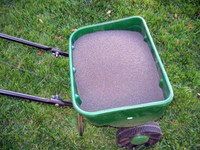Dakota Gardener: It’s a great time to fertilize your lawn
(Click an image below to view a high-resolution image that can be downloaded)
By Tom Kalb, Horticulturist
NDSU Extension
Early fall is the most important time to fertilize your lawn.
The key to a beautiful lawn is a strong, deep root system. Your lawn grows most of its roots in fall.
Feed your lawn around Labor Day and it will grow stronger, deeper roots this fall.
As a bonus, fertilizing in early fall can repair any damage to your lawn caused by the heat of summer, strengthen your lawn for the cold of winter and lead to a quicker green-up in spring.
Select a winterizer fertilizer. This fertilizer has the nitrogen your lawn needs and a boost of potash to prepare the lawn for winter.
A bag of fertilizer will have three numbers on it. These numbers indicate the percentages of nitrogen, phosphate and potash inside.
Nitrogen is the most important nutrient. Look for a fertilizer with at least 20% nitrogen. Select a fertilizer that contains some slow-release nitrogen, if available. This will gradually feed the lawn this fall and next spring.
The second number, phosphate, is abundant in our soils and is rarely needed in established lawns.
The third number, potash, will help your lawn to tolerate winter and other stresses. Most winterizer fertilizers contain 5% to 10% potash.
Don’t worry about these exact numbers, but a fertilizer that approximates 25-0-10 is best for most lawns in fall.
Fertilize at a rate of approximately 1 pound of actual nitrogen per 1000 square feet of lawn area.
You may wonder how much is 1 pound of actual nitrogen.
Four pounds of a fertilizer with 25% nitrogen provides 1 pound of actual nitrogen. Likewise, 3 pounds of a 33% nitrogen fertilizer provides 1 pound of actual nitrogen.
For a uniform distribution of the fertilizer, apply it in two directions going at right angles to one another. For example, apply half of the fertilizer going in north and south directions, and the other half going east and west directions.
Irrigate the lawn after applying your fertilizer. This increases the effectiveness of the fertilizer, prevents the fertilizer from burning the grass, and reduces the likelihood the fertilizer will runoff the soil during a rainstorm.
Weed-and-feed fertilizers are convenient but not ideal. That’s because now is the best time to feed your lawn, but it is not the best time to kill weeds. You will get a better kill if you wait until mid to late September.
Weed-and-feed fertilizers are not the best choice for the environment either. Trees and other landscape plants grow better when herbicides are sprayed only where needed on lawns. Using weed-and-feed fertilizers puts toxic chemicals everywhere, even in areas with no weeds.
As an alternative, spot sprays of liquid herbicide applied directly onto weedy areas can be applied to kill weeds at the most effective time and in a more effective manner.
Everything is getting more expensive now. This includes fertilizer. It’s important to fertilize when you can have the greatest impact.
Early fall is the time. Let’s get ready!
For more information about gardening, contact your local NDSU Extension agent. Find the Extension office for your county at www.ndsu.edu/agriculture/extension/county-extension-offices.
NDSU Agriculture Communication – Aug. 30, 2022
Source: Tom Kalb, 701-328-9722, tom.kalb@ndsu.edu
Editor: Kelli Anderson, 701-231-6136, kelli.c.anderson@ndsu.edu




